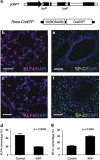KLF4 regulates adult lung tumor-initiating cells and represses K-Ras-mediated lung cancer
- PMID: 26113043
- PMCID: PMC4716302
- DOI: 10.1038/cdd.2015.85
KLF4 regulates adult lung tumor-initiating cells and represses K-Ras-mediated lung cancer
Abstract
Lung cancer is the leading cause of cancer-related mortality in both men and women worldwide. To identify novel factors that contribute to lung cancer pathogenesis, we analyzed a lung cancer database from The Cancer Genome Atlas and found that Krüppel-like Factor 4 (KLF4) expression is significantly lower in patients' lung cancer tissue than in normal lung tissue. In addition, we identified seven missense mutations in the KLF4 gene. KLF4 is a transcription factor that regulates cell proliferation and differentiation as well as the self-renewal of stem cells. To understand the role of KLF4 in the lung, we generated a tamoxifen-induced Klf4 knockout mouse model. We found that KLF4 inhibits lung cancer cell growth and that depletion of Klf4 altered the differentiation pattern in the developing lung. To understand how KLF4 functions during lung tumorigenesis, we generated the K-ras(LSL-G12D/+);Klf4(fl/fl) mouse model, and we used adenovirus-expressed Cre to induce K-ras activation and Klf4 depletion in the lung. Although Klf4 deletion alone or K-ras mutation alone can trigger lung tumor formation, Klf4 deletion combined with K-ras mutation significantly enhanced lung tumor formation. We also found that Klf4 deletion in conjunction with K-ras activation caused lung inflammation. To understand the mechanism whereby KLF4 is regulated during lung tumorigenesis, we analyzed KLF4 promoter methylation and the profiles of epigenetic factors. We found that Class I histone deacetylases (HDACs) are overexpressed in lung cancer and that HDAC inhibitors induced expression of KLF4 and inhibited proliferation of lung cancer cells, suggesting that KLF4 is probably repressed by histone acetylation and that HDACs are valuable drug targets for lung cancer treatment.
Figures





References
-
- 1Siegel R, Ma J, Zou Z, Jemal A. Cancer statistics, 2014. CA Cancer J Clin 2014; 64: 9–29. - PubMed
-
- 2Sun S, Schiller JH, Gazdar AF. Lung cancer in never smokers—a different disease. Nat Rev Cancer 2007; 7: 778–790. - PubMed
-
- 3Westra WH, Slebos RJ, Offerhaus GJ, Goodman SN, Evers SG, Kensler TW et al. K-ras oncogene activation in lung adenocarcinomas from former smokers. Evidence that K-ras mutations are an early and irreversible event in the development of adenocarcinoma of the lung. Cancer 1993; 72: 432–438. - PubMed
-
- 4Johnson L, Mercer K, Greenbaum D, Bronson RT, Crowley D, Tuveson DA et al. Somatic activation of the K-ras oncogene causes early onset lung cancer in mice. Nature 2001; 410: 1111–1116. - PubMed
Publication types
MeSH terms
Substances
Grants and funding
LinkOut - more resources
Full Text Sources
Other Literature Sources
Medical
Molecular Biology Databases
Miscellaneous

